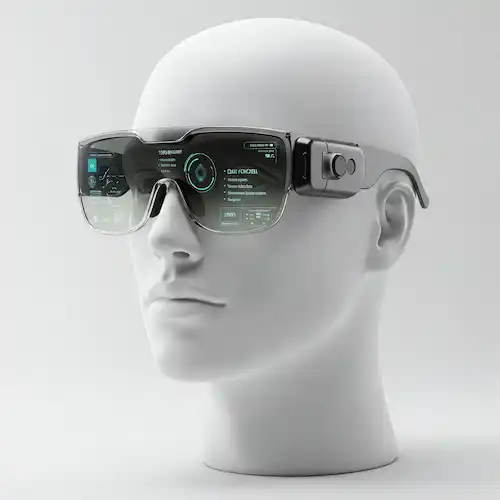The World of Smart Glasses: A Technological Overview
Smart glasses technology is rapidly evolving, blurring the lines between the digital and physical worlds. These innovative devices utilize a fascinating array of technologies, from advanced display systems and augmented reality capabilities to artificial intelligence and sophisticated sensor integration. This post delves into the core components that power smart glasses, exploring the various types of displays, the role of AR and AI, connectivity options, and the diverse range of sensors that contribute to their functionality. We’ll also examine the different categories of smart glasses, from those focused on augmented reality experiences to those designed for fitness tracking or enterprise use, offering a comprehensive overview of this exciting and rapidly expanding field.

Smart glasses are rapidly evolving, offering a blend of functionality and style. These devices utilize a range of cutting-edge smart glasses technology to enhance our daily lives, from augmented reality experiences to hands-free communication.
Key Technologies in Smart Glasses
- Display Technologies

- Waveguide Optics: These systems use a series of mirrors or prisms to project images onto the user’s retina, creating a virtual display that appears to float in the user’s field of view.
- Micro-OLED Displays: These tiny screens project images directly onto the user’s retina, offering high contrast and vibrant colors.
- Virtual Retinal Display (VRD): This technology scans images directly onto the user’s retina, providing a clear and crisp display.
- Augmented Reality (AR)

AR technology overlays digital information onto the real world, enhancing the user’s perception of their surroundings. Smart glasses with AR capabilities can provide navigation assistance, real-time information, and interactive experiences.
- Artificial Intelligence (AI)

AI powers many of the features in smart glasses, including voice recognition, image recognition, and natural language processing. This allows users to interact with their devices hands-free and access information quickly.
- Connectivity

Smart glasses typically connect to smartphones or other devices via Bluetooth or Wi-Fi, allowing users to access a wide range of features and applications.
- Sensors

Smart glasses often include a variety of sensors, such as accelerometers, gyroscopes, and cameras, which can be used to track user activity, capture images and videos, and provide contextual information.
Types of Smart Glasses Technology
- Augmented Reality (AR) Glasses: These glasses overlay digital information onto the real world, providing a hands-on experience.
- Virtual Reality (VR) Glasses: These glasses immerse the user in a virtual world, blocking out the real world.
- Mixed Reality (MR) Glasses: These glasses combine AR and VR technologies, allowing users to interact with both the real and virtual worlds.
- Fitness and Health Tracking Smart Glasses: These glasses track user activity and provide feedback on fitness goals.
- Audio Smart/Fashion Glasses: These glasses focus on providing a hands-free audio experience, with features like built-in speakers and microphones.
- Enterprise and Industrial Smart Glasses: These glasses are designed for business and industrial use, offering features like augmented reality for remote assistance and data visualization.
Frequently Asked Questions about Smart Glasses Technology
General Questions
Q: What are smart glasses?
A: Smart glasses are wearable computing devices that overlay digital information onto the user’s field of vision or provide other computer-generated enhancements. They often combine elements of augmented reality (AR), virtual reality (VR), and traditional eyewear.
Q: How do smart glasses work?
A: Smart glasses utilize various technologies like waveguide optics, micro-OLED displays, and virtual retinal displays to project images onto the user’s eye. They often incorporate cameras, sensors, and connectivity features (Bluetooth, Wi-Fi) to interact with the environment and other devices.
Q: What are the benefits of using smart glasses?
A: Benefits vary depending on the type of smart glasses, but can include hands-free information access, navigation assistance, real-time data display, enhanced communication, improved productivity, and immersive entertainment experiences.
Q: What are the different types of smart glasses?
A: Smart glasses can be broadly categorized into AR glasses (overlaying digital information onto the real world), VR glasses (immersing the user in a virtual world), mixed reality (MR) glasses (combining AR and VR), and simpler notification-focused or audio-focused smart glasses.
Q: How much do smart glasses cost?
A: The cost of smart glasses varies widely depending on features and capabilities. Basic notification or audio-focused glasses can be relatively affordable, while advanced AR/VR glasses can cost hundreds or even thousands of dollars.
Technical Questions – Smart Glasses Technology
Q: What is the difference between AR and VR?
A: AR (Augmented Reality) enhances the real world with digital information, while VR (Virtual Reality) creates a completely immersive digital environment.
Q: How is the display projected onto the eye in smart glasses?
A: Several methods are used, including waveguide optics (using mirrors and prisms), micro-OLED displays (tiny screens projecting images), and virtual retinal display (scanning images directly onto the retina).
Q: What kind of connectivity do smart glasses use?
A: Most smart glasses connect to smartphones or other devices via Bluetooth or Wi-Fi. Some may also have cellular connectivity.
Q: What sensors are typically included in smart glasses?
A: Common sensors include accelerometers, gyroscopes, cameras, microphones, and sometimes even environmental sensors like GPS.
Q: How is the battery life of smart glasses?
A: Battery life varies greatly depending on the model and usage. Power-intensive AR/VR applications will drain the battery faster than simpler notification or audio functions.
Privacy and Safety Questions
Q: Are smart glasses a privacy concern?
A: Yes, smart glasses with cameras raise privacy concerns as they can potentially record video and audio without others’ knowledge. Users should be mindful of privacy implications and use the devices responsibly.
Q: Are smart glasses safe for the eyes?
A: While generally considered safe, prolonged use of smart glasses can lead to eye strain or discomfort. It’s important to take breaks and follow the manufacturer’s guidelines.
Q: Can smart glasses be used while driving?
A: Using smart glasses while driving is generally discouraged and may even be illegal in some jurisdictions, as it can be a significant distraction.
Future of Smart Glasses
Q: What is the future of smart glasses technology?
A: The future of smart glasses looks promising, with ongoing advancements in display technology, AI integration, and miniaturization. We can expect to see more widespread adoption and new applications in various fields.
Q: What are some potential applications of smart glasses?
A: Potential applications are vast, including navigation, hands-free communication, real-time translation, remote assistance, training, gaming, entertainment, and healthcare.
Q: When will smart glasses become mainstream?
A: While smart glasses are not yet mainstream, increasing technological advancements, decreasing costs, and growing consumer interest suggest they could become more common in the coming years.
Additional helpful information:
More about the future of smart glasses – The Future of Smart Glasses – What is coming?
Smart Glasses Accessibility emerging technologies – Smart Glasses Accessibility Tech & AR/VR
Some of the benefits of smart glasses – Benefits of Wearing Smart Glasses
You can use smart glasses for navigation using GPS – Smart Glasses With GPS and Navigation Services




